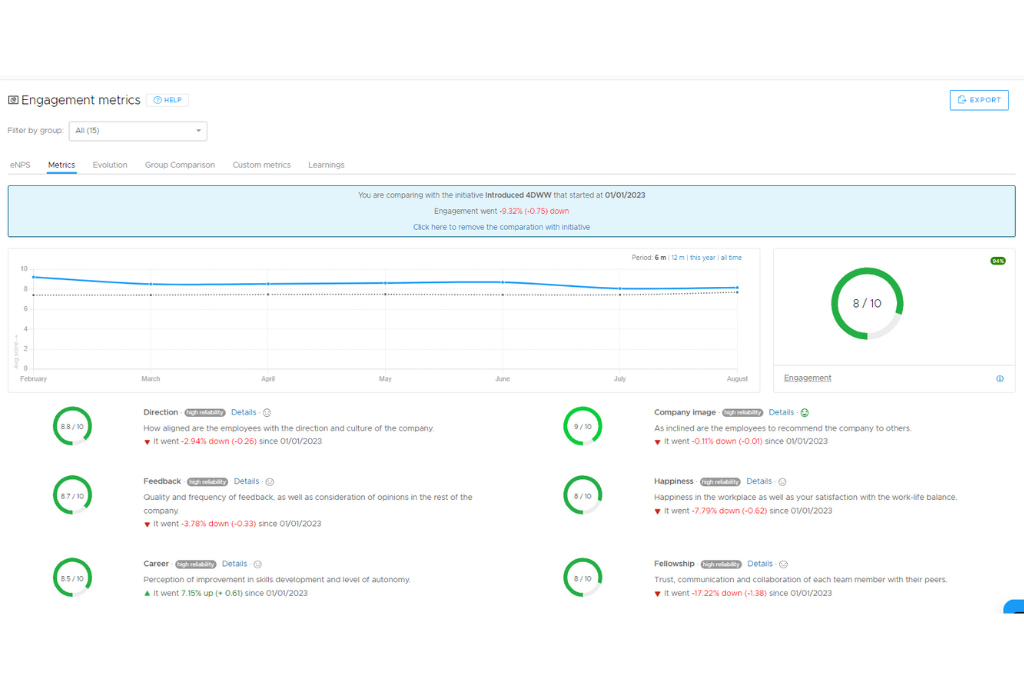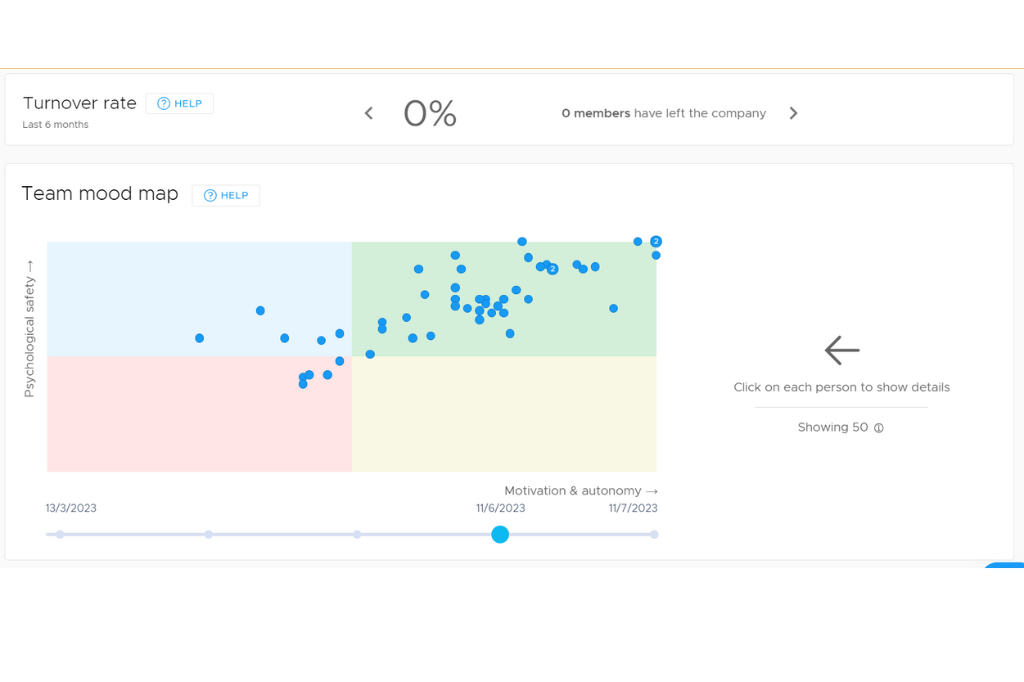In today’s competitive business landscape, organizations are increasingly recognizing the critical importance of employee engagement and its impact on productivity, performance and overall success. Therefore, understanding how to improve employee engagement is key to creating a positive work environment and unlocking the full potential of your workforce.
In this article, we will guide you through the 7 essential steps to creating an effective employee engagement program. By following these points, you will encourage your employees to give their best, increase their satisfaction and foster a strong commitment to the organization!
To enhance your understanding in employee engagement, we invite you to explore our comprehensive best practices guide on employee engagement. This resource will provide you with additional ideas and strategies to complement the seven steps outlined below.
Together, these resources will equip you with the knowledge and tools you need to cultivate a culture of engagement and drive sustainable success within your organization.
7 Steps to create an employee engagement program
An employee engagement program involves a set of strategies, along with employee engagement initiatives and activities aimed at creating a culture in which employees feel valued, motivated and aligned with the company culture.
With an employee engagement program you can improve various aspects of the employee experience, such as communication, employee recognition, professional development, work-life balance and overall well-being. What really matters is that you adapt the program to the needs of your employees.
If as an HR professional you are wondering how to improve employee engagement, pay attention to the following steps to create an employee engagement program:
- Identify what you need to improve.
- Set clear goals and objectives.
- Collect feedback and explore solutions.
- Design and implement targeted initiatives.
- Encourage active employee participation.
- Monitor and evaluate the program.
- Continuously optimize and adjust.
1. Identify what you need to improve
To create an effective employee engagement program, it is crucial to start by knowing what really is employee engagement and understand its current state within your organization. To do this, it is important to take a proactive approach. Only then can you find out if your employee engagement program is aligned with the needs and aspirations of your workforce.
This task involves conducting interviews, surveys and assessments to gather valuable feedback from employees. By actively listening to their feedback, you can better understand their needs and concerns.
In addition, and here’s the crux of the matter, you can identify specific action areas that require attention and improvement. So take the time you need to understand the challenges and opportunities specific to your organization.
During the identification phase, it is important to consider both quantitative and qualitative data. You can gather quantitative data using scales in your surveys. and qualitative information through open-ended questions. Also, you can organize focus groups to better understand employee experiences and perceptions.
2. Encourage active employee participation
For an employee engagement program to be successful, it is critical to encourage active employee participation. Employees must not only be aware of the program, but also understand its purpose, its benefits and their role in its success. In fact, with respect to employee participation, don’t forget to plan how you will involve those who work remotely.
For this reason, start by clearly communicating the goals and objectives of the program to all employees. Use whatever communication channels you consider: team meetings or internal newsletters. The important thing is to make sure the message gets to everyone.
Next, provide employees with a clear understanding of their roles and responsibilities. Make sure they know how their input can make a difference and contribute to the overall success of the program. Encourage open dialogue and create opportunities for employees to share their ideas, suggestions and concerns related to the program.
3. Set clear goals and objectives
Establishing clear goals and objectives is a critical step in creating an effective employee engagement program. These goals provide direction, focus and a framework for measuring progress.
When setting goals, it is important to make them measurable and align them with your organization’s overall objectives. Not only that, but they need to be related to previously identified areas of improvement. In this way, you ensure that the goals have a purpose and contribute to the desired results.
An effective approach is to use the SMART framework. But what is a SMART framework? It is an acronym for Specific, Measurable, Achievable, Relevant and Timely. Each letter represents a key characteristic that an objective should possess:
Specific: The objective should be clear, concise and well-defined.
Measurable: The objective should be quantifiable and include specific criteria for measuring progress and success.
Achievable: The objective should be realistic and achievable taking into account available resources, capabilities and constraints.
Relevant: The objective should be aligned with the overall goals and priorities of the individual, team or organization.
Timely: The objective should have a specific time frame or deadline for its achievement.
By setting SMART goals, you will provide clear direction for your employee engagement program and enable effective tracking of progress and success. Let’s look at an example of an objective related to a specific key performance indicator (KPI).
Goal example: Increase employee satisfaction rate by 10% in the next six months.
Why is this goal SMART? The objective is specific because it focuses on something in particular, employee satisfaction. It is measurable because it allows you to track progress and determine if the desired 10% increase has been achieved. The goal is also achievable because a 10% increase in employee satisfaction rate is a realistic target that can be accomplished within a defined timeframe. It is relevant because it is aligned with the objective of improving employee engagement. Finally, it specifies a six-month timeframe for reaching the goal.
4. Collect feedback and explore solutions
As discussed above, gathering employee feedback is an essential step in exploring possible solutions. Thus, by actively seeking feedback from your employees, you can gain valuable insights into their perspectives, needs, and expectations.
There are several methods for gathering employee feedback. One common way is to conduct surveys. In this context, in Nailted you can find preconfigured surveys and create your own surveys with customized questions to find the information you are looking for. These surveys can include questions about job satisfaction, communication effectiveness, growth opportunities and overall employee experience.
In addition to surveys, think in one-on-one meetings as a valuable source of information to gather more detailed insights. The best part is that you can easily organize, schedule and track these meetings with Nailted.
Another option is to arrange brainstorming sessions with stakeholders, such as HR professionals, managers and even employees themselves. During these sessions, encourage an open and constructive dialogue that allows for the free flow of ideas and the identification of practical actions.
By involving employees and managers in this process, you foster a collaborative culture in which everyone has a voice in shaping the employee engagement program.

5. Design and implement targeted initiatives
Once you have identified areas for improvement and established clear goals for your employee engagement program, it is time to design and implement specific initiatives that address those areas. Needless to say, these initiatives must align with the overall goals and objectives of the program.
To design effective initiatives, start by analyzing the feedback and data collected during the identification phase. Look for common themes that emerged from the feedback and identify specific areas that require attention.
If communication was identified as an area for improvement, you can design initiatives that promote transparent and effective communication channels within the organization. What kind of initiative can be useful in this matter? For example, HR professionals can create a regular newsletter or internal blog that provides updates on company news, achievements and important information.
Also consider the resources available and the timeline for implementation. Break down initiatives into actionable steps and assign responsibilities to the people or teams that will be responsible for their implementation. It is essential to ensure clear communication and support for those involved in delivering the initiatives.
6. Monitor and evaluate the program
To ensure the success of your employee engagement program, it is critical to monitor and evaluate its effectiveness. So you must measure employee engagement on an ongoing basis. This will allow you to make data-driven decisions and continuously improve the program’s impact.
But how can you evaluate and monitor your program? By using the right employee engagement metrics and KPIs. In fact, having an accurate measurement of employee engagement metrics provides valuable insights on overall the employee experience. By doing so, you can identify areas for improvement to make informed decisions and create a more positive and productive work environment.
Did you know that Nailted allows you to track the metrics of your employee engagement program? Thanks to our Initiatives feature. Initiatives are meaningful actions that you can implement in the context of your program development as an HR professional.
For example, imagine that your company decided to implement the 4-day work week. When creating this initiative you can assign a specific metric to it, such as eNPS. In addition, you can choose the time period during which you will track the progress of this initiative.

By associating an initiative with a metric you can see how it impacts that metric. This way of tracking metrics across initiatives gives you a deeper understanding of how your employee engagement program works. In other words, Nailted allows you to know if the initiatives you propose are having an effect.
7. Continuously optimize
It is important to view your employee engagement program as a dynamic process that evolves with the changing needs and aspirations of your workforce. Thus, it is essential to adopt a continuous improvement mindset, thus ensuring the effectiveness of your employee engagement program.
In this sense, this involves reviewing the results of the assessment and making the necessary adjustments and optimizations to align the program with employee needs and organizational goals.
Once you have evaluated the program using KPIs and gathered qualitative feedback, analyze the data to identify areas for improvement or potential challenges. Look for patterns, trends and specific feedback that can guide your decision-making process.
Based on the evaluation results, consider making adjustments to various aspects of the program and communicate changes and updates to all stakeholders involved in the program in a transparent manner.

Employee engagement plan template
Creating and maintaining a highly engaged workforce is a strategic priority for organizations looking to drive productivity, innovation and overall business success. But it’s not always an easy task.
To help you develop your own customized plan, we’ve put together an employee engagement plan template that you can download. Our guided, easy-to-fill-out template provides you with a valuable resource to create a comprehensive roadmap for optimizing employee engagement within your organization.
See for yourself how you can streamline the process of creating your own customized employee engagement program. So don’t wait any longer and download the template!
At Nailted, we understand the importance of working on your employees’ experience; creating a culture of engagement, growth and success within your organization.
That is why we have developed our employee engagement software. With our People Analytics feature, you can measure and analyze your engagement levels in real-time. In addition, you will be able to access a mood map and metrics evolution, allowing you to get a clearer view of your company’s engagement progress.

Best of all, Nailted will be with you every step of the way, making sure you work through the processes necessary to effectively improve engagement: employee recognition, 1:1 meetings, performance reviews, and more!
To sum up, improving employee engagement should not be a one-time effort, but a constant and ongoing commitment. By adopting a culture of continually improving engagement levels, you can foster an environment where employees feel valued, motivated, and empowered to reach their full potential.
Want more reasons? Book a demo and the experts in our People and Culture team will be happy to guide you toward creating a happier, more engaged workplace!










